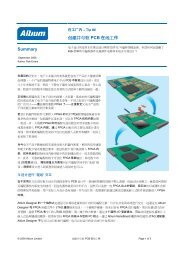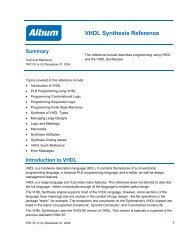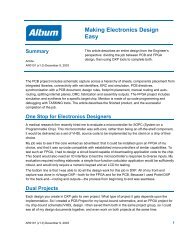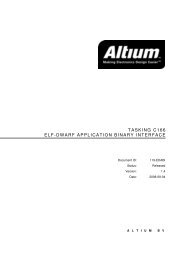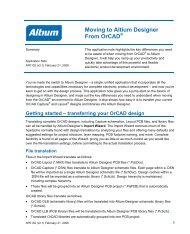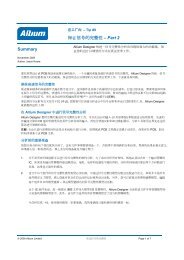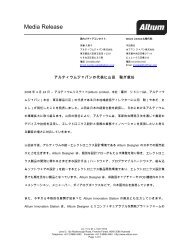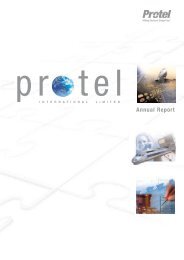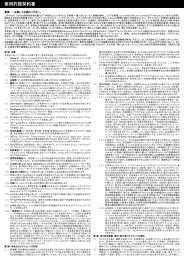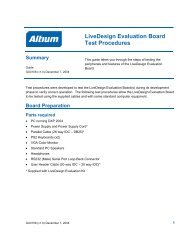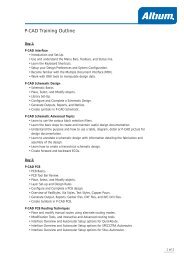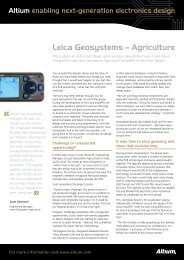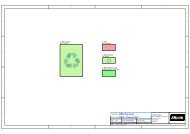Elektronikk 05-2010 - Altium
Elektronikk 05-2010 - Altium
Elektronikk 05-2010 - Altium
You also want an ePaper? Increase the reach of your titles
YUMPU automatically turns print PDFs into web optimized ePapers that Google loves.
Touch Technology: The Norwegian Connection<br />
Touch sensors are well on their way to replace mechanical devices like buttons, sliders and<br />
wheels. And new tools will make this much easier. We met with the technology provider Atmel<br />
Norway AS, tool provider <strong>Altium</strong> Europe and the user Jotron Phontech AS.<br />
By Einar Karlsen<br />
Tools provider <strong>Altium</strong> delivers what they call a unified design system, which by definition has removed<br />
any hurdles between the different stages of the design process, from schematics through to PCBlayout,<br />
FPGA design and 3D modeling, to name just a few. In addition, <strong>Altium</strong> offers a large selection<br />
of hardware platforms for rapid prototyping and early verification of new application ideas. It is this<br />
combination that has been accepted worldwide, and in Norway this interest made it necessary to<br />
establish a distributor, a role 4test Instrument AS took over in late autumn.<br />
<strong>Altium</strong> has a growing user group<br />
in Norway, and especially the<br />
cooperation with Atmel Norway<br />
about the design of the touch<br />
sensors may be important. Jonny<br />
Langmyren and Bjorn Birkeland<br />
from 4TEST, Arild Rødland from<br />
Atmel Norway, Rainer Heim from<br />
<strong>Altium</strong>, Anton Søberg and Atle<br />
Martin Christiansen of Jotron<br />
Phontech.<br />
The Engineer in focus<br />
”We are a technology based company, which is based on the fact that our founder many years ago<br />
was not satisfied with the tool he used, and therefore made his own. We have retained this ‘spirit’ and<br />
we invest in tools that are based on the latest technology, and which are easy to use”, explains sales<br />
manager for Northern Europe, Rainer Heim. “None of my customers have returned any products so<br />
far”, he adds.<br />
Cooperation with Atmel Norway<br />
Norway has been very interesting for <strong>Altium</strong>, especially with regard to the agreement that was recently<br />
signed with Atmel. Briefly told, the agreement is about the integration of design tools for Atmel touch<br />
sensor technology in <strong>Altium</strong> Designer. “They contacted us and told us that they wanted to standardize<br />
on <strong>Altium</strong>.<br />
I must admit it was a bit of a surprise - they could have chosen any supplier”, says Rainer Heim. “But<br />
we realized quickly that this was not a ‘regular’ customer. Moreover, frankly we could see that Atmel’s<br />
position in the microprocessor market would help us to get more visibility in the market”, he said.<br />
A number of touch sensors,<br />
for example wheels can be<br />
difficult and time consuming<br />
to design manually. Now,<br />
technology from Atmel can<br />
be implemented in <strong>Altium</strong><br />
Designer, so that this<br />
process can be automated.<br />
Issue <strong>05</strong>-<strong>2010</strong><br />
(translation by <strong>Altium</strong>)
Touch Sensors take over<br />
The market for touch technology is about to widen. “Market surveys show that three-quarters of those<br />
who still use mechanical buttons today are interested in considering capacitive touch sensors”, says<br />
marketing manager Arild Rødland, Atmel Norway AS.<br />
An important reason for this is simple maintenance and cleaning. “Regular keys are expensive to<br />
waterproof. At the same time the mechanical performance of membrane keys is poor”, explains Mr.<br />
Rødland. “Capacitive buttons, however, can easily be made moisture-proof; they offer great design<br />
freedom, no degradation of performance over time and are cost effective”, he said.<br />
QTouch<br />
The Atmel QTouch technology series comprises two main lines: simple touch-sensing buttons, sliders<br />
and wheels, and full-resolution touch screens. 'Many applications can be managed with simple<br />
buttons, and QTouch is delivered with fixed function components for easy implementation, but<br />
together with the QTouch Library variable functions and analytical models can be used to tune the<br />
sensors.<br />
Basic errors<br />
“Good design support is important”, says Rødland. “We see that even big mobile phone companies<br />
make basic mistakes on the touch screens”, he adds.<br />
“Therefore, we have developed a powerful software package that will help making more robust and<br />
better products than the competition. Their products will work well enough in the lab - but what<br />
happens in production, not to mention in 'real life’”, he asks with a smile.<br />
Production Problems<br />
The experienced designer Martin Atle Christiansen of Jotron Phontech confirm this problem. “We<br />
manufacture thousands of touch panels each year and are experiencing major problems in<br />
production”, he said. “In addition, we have different needs in different markets, which also give us<br />
great design challenges. Therefore we think it is very interesting that Atmel and <strong>Altium</strong> come with an<br />
automated solution for this technology”, he said.<br />
Should be easy<br />
Atmel is now entering the next phase of the design of these components: It should be an easy<br />
to use tool for the design of touch buttons. The designers have had plenty of support, with the<br />
Atmel 70-page (!) manual for the design of touch sensors. “It is well written and exhaustive, but<br />
can also be intimidating”, admits Mr. Rødland.<br />
Demanding Design<br />
For example, the PCB design of a touch sensor in the shape of a wheel might at first glance seem<br />
straight forward, but is in fact a challenging exercise to draw in the first place. If the size of the wheel<br />
has to be changed, it is a complete redraw. “Our designers could spend a whole day just to make such<br />
a wheel. It is a lot of work to change some of the geometrical dimensions or change the number of<br />
channels, etc. Being able to automate this work will save a lot of time, and that was basically the<br />
starting point for making contact with <strong>Altium</strong>” says Rødland.<br />
Automated<br />
It is not always easy to gain access to the tool manufacturers. But with <strong>Altium</strong>, Atmel experienced a<br />
short way to the decisions. “Once we knew what they were interested, everything went fast”, confirms<br />
Rainer Heim. “The founder of <strong>Altium</strong> Nick Martin recognized immediately that we could integrate this in<br />
<strong>Altium</strong> Designer. Atmel Norway developed a pattern generator that produces an xml type file to <strong>Altium</strong><br />
Designer, which we use to integrate this into the design specifications.”<br />
A hit<br />
Jotron Phontech is a company that already has used <strong>Altium</strong> for a while, and will now take advantage<br />
of this new functionality for the design of touch sensors. The company began with two <strong>Altium</strong> licenses<br />
half a year ago and has just bought two more. Now it is decided that the Jotron Group with its 40<br />
engineers will use <strong>Altium</strong> as generic tools. “I think it was a gap in the market, which <strong>Altium</strong> filled very<br />
well”, commented Martin Atle Christiansen.<br />
Issue <strong>05</strong>-<strong>2010</strong><br />
(translation by <strong>Altium</strong>)
The right tools<br />
”<strong>Altium</strong> Designer came in with an excellent ‘look and feel’, and was easy to become a fan and<br />
passionate user of it”, he says straight out. “Basically, we wanted a design tool for printed circuit<br />
boards, but when we saw all the other functionality included – it even supports FPGA design - it was<br />
easy to see that this was the right tool for us”, explains Mr. Christansen.<br />
Play and gravity<br />
”In general we try to create tools that help engineers to concentrate on developing their ideas”, adds<br />
Rainer Heim. “Not everyone sees <strong>Altium</strong> as a serious player in the EDA market and <strong>Altium</strong>’s price<br />
policy has been criticized, with the company being accused of either not providing adequate systems,<br />
or selling them at prices they could not possibly make a profit on. No, we do not sell too cheaply. But<br />
we offer the best value for money”, parries Rainer Heim. “We are in a very good position with a rapidly<br />
growing user base and sound finances. In only 6 months we have sold our system to 1,600 new<br />
customers worldwide.”<br />
Easy integration<br />
Robert Huxel from <strong>Altium</strong> demonstrated a prototype of the touch sensor module, which will be<br />
available in the next version of <strong>Altium</strong> Designer. In the schematic entry it is simply to select a touchbutton<br />
from the library, and call up a dialog box to change the element. You can easily change the<br />
number of channels, height, width, diameter, etc.<br />
The physical dimensions / layout are<br />
created on the fly when the component<br />
is added into the physical design.<br />
”This workflow makes it a simple task for<br />
example to add ‘last minute’ changes to<br />
a front panel, explains Huxel. As<br />
mentioned elsewhere, it would be a lot<br />
of work to change this manually.<br />
"Certain types of shapes are very<br />
difficult to create or edit by hand, Huxel<br />
points out. "It is also easy to add the<br />
routing and connect the shapes exactly<br />
with the point you want", he said. In a<br />
next step the system will be integrated in<br />
a demo-/development kit from Atmel.<br />
Natural way forward<br />
4test is probably best known as a distributor of instruments from Agilent, in addition to other instrument<br />
products from Maury Microwave, VTI Instruments, QualiTest Technologies and TCI. But at the same<br />
time they have also delivered the HF / RF design software from Agilent EEsof, so according to sales<br />
manager Jonny Langmyren it was quite natural to take in <strong>Altium</strong> when they looked for a distributor in<br />
Norway. “After a few months we are already experiencing good activity”, he said. “<strong>Altium</strong> has pulled all<br />
the stops in order to make itself visible in Norway and gives us very good support”, says Mr.<br />
Langmyren.<br />
Issue <strong>05</strong>-<strong>2010</strong><br />
(translation by <strong>Altium</strong>)



